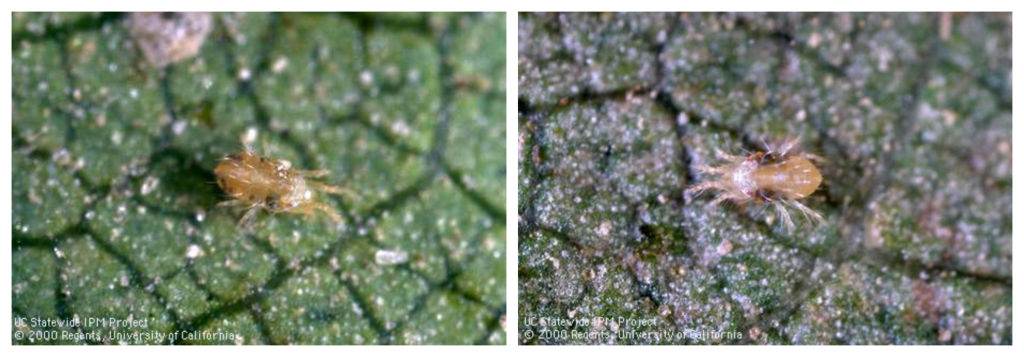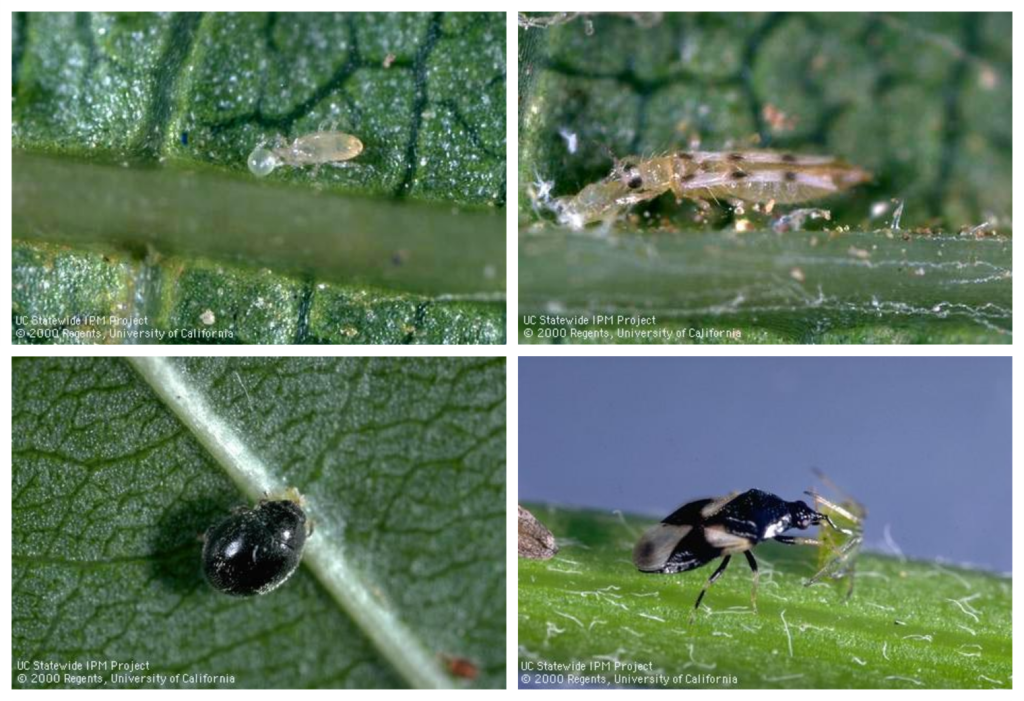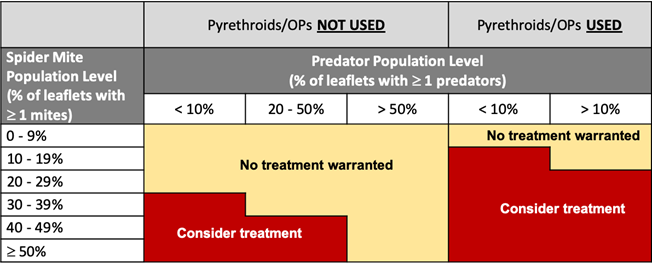Originally written by Emily J. Symmes, Former Sacramento Valley Area IPM Advisor
Revised in June 2024 by Sudan Gyawaly, Sacramento Valley Area IPM Advisor
The good news is that a truly sound IPM program should already have you considering economic costs and returns when making pest management decisions. Economic treatment thresholds for pest management can be distilled into a formula that considers the following: cost of the management tactic, value of the crop, damage (crop loss in yield or quality per pest and unit area, e.g., lbs lost/acre or lbs downgraded/acre), and how effective the management tactic is. Simply put, a management tactic (whether chemical or otherwise) should be applied only when the benefits outweigh the costs (no major revelations here!). We can view this formulaic approach with the following equation, where the “economic injury level” represents the pest population density at or above which treating “pays”:
From this simplified approach, we see that when crop value decreases, as is the current situation for walnuts, the population level at which it “pays” to treat increases. The same is true when damage decreases, effectiveness of treatment decreases, or management costs increase (Table 1).
Keeping these basics in mind, what are the main insect and mite pests that can impact walnut yield and quality during the summer, and what is the best IPM strategy for each?
Codling moth: The 2024 codling moth spring biofix in Northern Sacramento Valley was, for the most part, in the 2nd week of April. However, codling moth sprays were skipped in many orchards this spring for cost reasons or due to low moth pressure. Orchards not treated for codling moth in the 1-A/B flights might mean a larger second flight. Therefore, codling moth populations and damages must be carefully monitored to establish subsequent biofixes and guide spray decisions. In many ranches, the codling moth’s second flight has already begun (as of June 26th, when this article was written), and orchards considering codling moth treatments will likely spray for it over the next couple of weeks.
Approaches to codling moth management considering current market conditions were addressed in this post in 2019.
Spider mites:

Figure 1. Pacific spider mite (left) and two-spotted spider mite are two common web-spinning spider mite pests in walnuts.

Figure 2. Spider mite natural enemies common in walnuts: western predatory mites (top left), sixspotted thrip (top right), spider mite destroyer (bottom left) and minute pirate bug (bottom right).
- Rely on biological control. The basic tenets of conservation biocontrol are “don’t starve them & don’t kill them.” If predators are present in your orchard and have some food to eat (i.e., subeconomic populations of spider mites), they will stick around and the numbers of beneficials will increase. Avoid broad-spectrum pesticides (e.g., pyrethroids and organophosphates) at critical times of natural enemy population increase during the season (spring and early summer). Avoid applying prophylactic spider mite treatments before economic thresholds are reached.
- Impacts of commonly-used insecticide and miticides on natural enemies can be found at: ipm.ucanr.edu/agriculture/walnut/Relative-Toxicities-of-Some-of-the-Pesticides-Used-in-Walnuts-to-Natural-Enemies-and-Honey-Bees/
- Clean up populations as needed based on site-specific scouting of spider mites (Figure 1) AND natural enemies (Figure 2) according to published treatment threshold guidelines.
- Use materials that are less damaging to natural enemies where possible. Scout at least once weekly late May through August, noting percent presence/absence of spider mites and predators on leaf samples (5 low leaflets and 5 high leaflets from each of 10 randomly selected trees in the block). A scouting form is available at: ipm.ucanr.edu/PMG/C881/walnut-mitemon.pdf. UC IPM guidelines suggest the following treatment thresholds based on whether pyrethroid or organophosphates applied to target other pests have been or will be used this season (Table 2).
- In orchards where pyrethroid or organophosphate applications ARE NOT used, consider treatment if your samples show:
- 30 to 40% spider-mite infested leaflets and predators on less than 10% of the leaflets.
- 40 to 50% spider-mite infested leaflets and predators on 20 to 50% of the leaflets.
- No treatment warranted if predators are on 50% or more of the leaflets.
- In orchards where pyrethroid or organophosphate applications ARE used, consider treatment if your samples show:
- 10% spider-mite infested leaflets and predator mites on less than 10% of the leaflets.
- 20% spider-mite infested leaflets and predators on more than 10% of the leaflets.
Aphids:
- Rely on biological control (same basic tenets as above for conservation biological control of spider mite natural enemies). In addition to general predators, the more common aphid species encountered in walnut orchards (walnut aphid) has a very effective parasitoid natural enemy (if not disrupted).
- Monitor aphid populations weekly beginning in May and continuing throughout shoot and nut growth, noting which aphid species are present and their abundance, along with signs of parasitism (aphid mummies). Each week, examine 5 first-subterminal leaves from each of 10 randomly-selected trees in the block (total of 50 leaflets) (scouting form).
- Treat only as needed based on site-specific scouting for aphids and biocontrol evidence. UC IPM guidelines suggest the following treatment thresholds:
- Walnut aphids (typically on lower leaflet surface): Consider treatment if average of 15 or more non-parasitized aphids per leaflet in sample.
- Dusky-veined aphids (typically on upper leaflet surface): Consider treatment if average of 10% or more leaflets have live colonies of 6 or more aphids.
Walnut husk fly:
- Site-specific monitoring for walnut husk fly is critical, as orchard blocks even in very close proximity can differ in population abundance and treatment needs.
- Best practices for monitoring and treatment decisions/timing are available at UC Pest Managment Guidelines.
- Traps for walnut husk fly are most effective when placed high in the tree canopy (north side, in shaded or damp areas). It may be tempting to place traps where they can be easily reached from the ground, but it is not advised to cut corners with trap placement. Checking traps suspended from durable rope (paracord is my favorite) high in the tree canopy takes little to no extra time at each trap check once the ropes are deployed to start the trapping season, and your time will be rewarded by increased trap efficacy.
- Walnut husk fly activities in some Sacramento Valley orchards began much earlier than usual, as early as May 21 in 2024. For most growers, the husk fly flight activity started on time, and trap captures are currently picking up.
- Monitor traps a few times per week until two to three weeks before harvest (at which time treatments should cease). WHF populations can be very spotty, so make sure you are watching activity and treating only where needed.
- Partial coverage and low volume spray applications have been shown to be effective in most situations (unless populations are very high), and can save costs relative to high volume, full coverage sprays. More detail at: sacvalleyorchards.com/walnuts/insects-mites-walnuts/walnut-husk-fly-trap-and-low-volume-spray-study/ and UC Pest Management Guidelines
Navel orangeworm:
- Evaluate your risk potential for NOW damage this season. Factors to consider include:
- Susceptibility of variety.
- History of damage in the block.
- Carry-over potential from last season (how well sanitation was completed).
- In-season observations of population abundance (using traps or visual evidence of NOW infestation in mummies or damaged nuts).
- Proximity to external sources of NOW (especially almond blocks as they are harvested).
- Predictions of third and fourth flight overlap with husk split.
- Anticipated harvest date, ethephon use, and single vs. double shake approach at harvest.
- With lower crop values, second shakes are not always economic. Remember that any nuts left behind in the orchard (in trees, on the orchard floor, in surrounding areas) will need to be cleaned up to minimize overwintering and early season NOW resources heading into next year.
- If you have a susceptible variety with a history of NOW damage or are in proximity to immigrating sources of NOW and late season flights are abundant and overlap with the peak window of susceptibility (husk split through harvest), consider a pesticide application during this period. With the prolonged spring, we will likely see staggered nut maturation and husk split, which will increase the susceptibility window for NOW infestation. This is likely to make timing applications for NOW even more challenging. Aim for getting the most residual on the greatest amount of susceptible plant tissue (i.e., opening husk and shell) and bear in mind pre-harvest interval restrictions.
A few final, general thoughts on cost saving strategies. Many of these have to do with the following statement: the costliest application you will make is the one that didn’t work or wasn’t needed.
Where “cutting costs” is likely to pay off:
- Performing pest management activities (whether a pesticide application or other method) based on validated economic thresholds (may reduce overall inputs).
- Eliminating unnecessary materials in the tank.
- Spot treating if possible (at minimum, block-specific treatments).
- Prioritizing treatment locations and timing to achieve best results in the areas of greatest need.
Where “cutting costs” is unlikely to pay off:
- Skipping or reducing sprayer calibration efforts. Driving too fast or applying at volumes too low to achieve adequate coverage. If you are going to invest in materials and application, get the most bang for your buck!
- Applying at less-than-ideal timing, especially with many materials being more selective/less broad spectrum.
- Taking advantage of a “free ride” for an application if not the ideal time or it necessitates use of a less effective material.
- Not monitoring to determine pest populations, damage potential, need for management activities.
- Not rotating chemistries (especially where resistance development is a concern).
- Using below-label rates.
- Skipping proven cultural practices (e.g., sanitation for NOW).





Leave a Reply